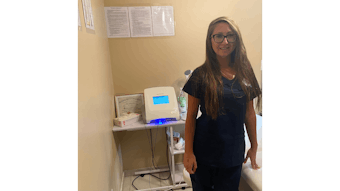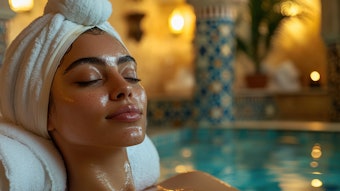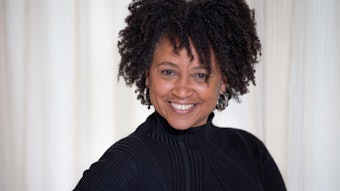
This week, we sat down with Karyna Haiduk, an aesthetics expert who's distinguished in depilation and brow design. An author and mentor in sugaring, waxing and skin care, in her more than 7 years of experience, she's founded her own professional sugar paste and post-care cosmetics brand, Fast-Silk. Haiduk is a recipient of the Berehynia of Ukraine, an award that acknowledges the distinct efforts of the winner's contributions to the country's development and support. As of 2024, Haiduk was granted the title, Ambassador of Epilation and Depilation, by the Golden Hands of Ukraine.
KL: How do you approach hair removal with a client that has severe active acne? Does your approach change depending on if it's face vs. body acne?
KH: As an experienced depilation specialist, I always approach such cases with great care and an individual strategy. When a client comes to me with severe acne, the first thing I do is assess the condition of their skin—this is absolutely essential. It’s important to determine whether the inflammation is in an active phase or already beginning to subside. If the acne is acute and the skin is highly irritated, I usually recommend postponing the procedure and consulting a dermatologist first. The client’s health always comes first. My approach definitely differs depending on the area being treated.
For facial areas, especially the cheeks and chin—where the skin is most sensitive—I do not perform hair removal on active breakouts. Doing so can worsen the condition. In some cases, I can carefully treat isolated zones, such as the space between the eyebrows if the skin there is calm. Even then though, I work very gently and avoid anything aggressive.
On the body, for example, the back, buttocks or chest, I evaluate the size and severity of the affected areas. If there are only a few breakouts and they are not inflamed, I may perform sugaring carefully, avoiding the problem spots to prevent irritation or trauma. I always use antiseptics before and after the procedure, wear gloves, maintain strict hygiene and use only disposable materials.
Overall, when working with acne-prone skin, the key is to take your time, listen to the client and their body and be as gentle as possible. Of course, I always give clear aftercare instructions to help avoid complications and ensure the skin heals properly.
KL: What professional acne treatments can't be paired with professional hair removal treatments?
KH: When a client comes to me who is undergoing acne treatment, I always start by asking what products and procedures they are currently using because not everything is safe to combine with hair removal.
First and foremost, I pay attention to retinoids—both oral (such as Roaccutane/Isotretinoin) and topical (creams containing retinol or tretinoin). These products make the skin very thin, dry and sensitive, which means even the gentlest hair removal can cause burns or lift the surface layer of the skin. So, during this kind of therapy, I usually recommend postponing hair removal for at least 4–6 months after the treatment ends.
I also do not combine hair removal with chemical peels, microdermabrasion, laser resurfacing or other intensive skin treatments that compromise the skin’s protective barrier. In such cases, the skin needs time to recover and I typically recommend waiting 7–14 days (depending on the procedure) before performing depilation
In addition, when clients are taking antibiotics or anti-inflammatory medications, the skin can become unstable and more prone to injury. That’s why an individual approach is essential, and sometimes I perform a patch test first. My goal is not just to perform a treatment, but to keep the client’s skin in healthy condition. That’s why I always start with a consultation to choose the best timing and safest technique. This approach ensures excellent results and minimizes the risk of complications.
KL: How can those of us performing depilation procedures tailor our post-care recommendations to our more acne-prone clients?
KH: As an experienced depilation specialist, I know for sure—there’s no one-size-fits-all solution. Especially when it comes to clients with acne-prone skin. Here, a more attentive and personalized approach is essential. I always start by assessing the skin type and the severity of acne. It’s one thing if there are occasional breakouts on the body and quite another if the client has oily, sensitive skin with frequent inflammation. Based on that, I select the gentlest, non-comedogenic products for both pre- and post-treatment care.
Here’s how I adapt my recommendations:
- Before the procedure, I advise avoiding heavy cosmetics, scrubs and acids, especially 2–3 days before sugaring or waxing.
- After the procedure, I recommend avoiding oils, heavy creams, self-tanners and fragranced lotions. Instead, I suggest gentle antiseptics like chlorhexidine, hydrolats or aloe-based gels.
- For acne-prone skin, I stay away from aggressive products and prefer lightweight lotions with anti-inflammatory ingredients or zinc-based powders to reduce irritation and prevent breakouts.
- I always remind clients: no tight clothing, exercise or saunas for 24–48 hours, especially if they have oily skin and easily clogged pores.
I also explain that it’s important to maintain not only a skin care routine but also good hygiene habits: clean clothing, breathable fabrics and avoiding touching the skin unnecessarily. If a client has more serious skin issues, I’m always open to collaborating with a dermatologist and adjusting my treatments to complement any prescribed therapy. For me, it’s not just about removing hair, it’s about helping the client prevent inflammation, avoid discomfort and feel confident in their body. That’s what true professionalism means in our field.
KL: Can you go into how you recommend different hair removal techniques to different clients?
KH: I always select the hair removal method individually, taking into account the client’s skin type, health condition, sensitivity level, pain threshold and even lifestyle. This is especially important for clients with acne-prone skin, since using the wrong method can lead to irritation or worsen inflammation.
Here’s how I approach method selection:
- For clients with sensitive, inflamed or acne-prone skin, I usually recommend sugaring. It’s gentle on the skin, doesn’t damage the top layer, washes off easily with water and the paste itself is hypoallergenic and has anti-inflammatory properties. It’s especially well-suited for delicate areas and oily, breakout-prone skin.
- For clients with normal, resilient skin that’s not prone to irritation, both waxing and sugaring can work well—depending on personal preference. Waxing is great for larger areas (like legs and arms), but requires careful aftercare to prevent ingrown hairs and irritation.
- For clients with coarse, dark or stubborn hair, especially on the face, I often recommend electrolysis. It’s the only hair removal method FDA-approved as 100% permanent. It’s a great option for people with hormonal imbalances or unwanted facial hair due to medical conditions. However, it’s not recommended when active inflammation is present.
- For clients with a low pain threshold or high anxiety, I suggest starting with sugaring on a small area. I explain the process thoroughly and create a calm, supportive environment and often, any fear disappears after the first session.
It’s important to remember that the method should be chosen based on what suits the client, not what’s most convenient for the specialist. My goal is to clearly explain the pros and cons of each method, properly prepare the skin, perform the treatment carefully and give aftercare instructions. That’s the only way to ensure safe, long-lasting results and happy, healthy skin.
KL: What other skin conditions require careful consideration when it comes to hair removal? What are some of the obstacles?
KH: Before every procedure, I always carefully examine the skin, because there are situations when hair removal should be done with caution—or postponed altogether.
Here are the main skin conditions I pay attention to:
- Couperose and rosacea: with these conditions, the skin is very sensitive and blood vessels are close to the surface. Waxing can worsen redness and irritation. In such cases, I prefer gentler methods like sugaring and avoid anything that could overheat or stress the skin.
- Active inflammation or infections: if there are boils, herpes, cuts or abrasions, the procedure should be delayed until the skin fully heals. Hair removal can spread infection or aggravate inflammation.
- Severe dryness and flaking: dry skin is more prone to microtears and damage. It’s important to restore moisture first before performing hair removal.
- Allergic reactions or eczema: during flare-ups, it’s best to wait until remission. I also always ask about any product allergies (e.g. honey, lemon, essential oils) to avoid triggering a reaction.
- Scars, burns, fresh tattoos or recent peels: these areas should not be treated. The skin needs time to recover completely before undergoing hair removal.
- Pregnancy and varicose veins: these aren’t absolute contraindications, but they do require a more delicate approach. It depends on how the client feels and the area being treated.
The most important thing is not to rush into a procedure “at any cost.” If the skin needs rest or treatment, I always explain that to the client. Sometimes it’s better to wait and properly prepare the skin than to risk burns, pigmentation or irritation.










